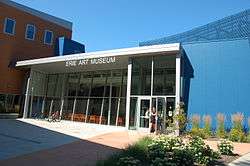Erie Art Museum
 | |
| Established | 1980, originally the Art Club of Erie est. 1898 |
|---|---|
| Location | 411 State Street Erie, Pennsylvania, USA |
| Type | Art Museum |
| Director | Joshua R. Helmer |
| Curator | Susan Barnett |
| Website |
erieartmuseum |
Erie Art Museum is an art museum in Erie, Pennsylvania. The Museum maintains an ambitious program of changing exhibitions, embracing a wide range of subjects, both historical and contemporary and including folk art, contemporary craft, multi-disciplinary installations, community-based work, and traditional media. It holds a collection of over 8,000 objects, with strengths in American ceramics, Tibetan paintings, Indian bronzes, contemporary baskets, photography, and many other mediums. The museum hosts 18 to 20 visiting exhibitions annually and shares parts of its collection with national and international partners through traveling exhibits.
The Museum offers a wide range of education programs and artists’ services including interdisciplinary and interactive school tours and a wide variety of classes for the community. Performing arts are showcased in the popular summer program, Mid Day Art Break, which represents national and international performers of serious music with an emphasis on composer/performers.
Museum complex
The Erie Art Museum anchors downtown Erie’s cultural and economic revitalization, occupying a group of restored mid-19th century commercial buildings and a modern, ‘Green,’ 10,500 square foot expansion. The museum entrance is situated on East 5th Street between State and French Streets. The 2010 wing connects four historic buildings into a single complex:
- The Old Custom House, a Greek Revival building constructed in 1837-39 of Vermont marble[1][2]
- The Cashiers House, a Greek Revival townhouse also completed in 1839[3]
- The Bonnell Block, a Greek Revival commercial building built in 1840 that houses the Erie Art Museum's Holstein Gallery and Frame Shop
- The Old Pumper House, the oldest surviving fire house in the city, originally built as a marble works in 1860
History
The Art Club of Erie was established in 1898 and met in the then-new Erie Library on Perry Square in downtown Erie. The Art Club moved to the Watson-Curtze Mansion in the 1940s. In 1956, the club raised money and found a home of its own in the Wood-Morrison House, adjacent to the Curtze Mansion. The new place was soon known as the Erie Art Center and had a professional director by 1968. The center became the Erie Art Museum in 1980 when it moved to the Old Custom House on State Street. The Ashby Printing Company building was purchased the same year and became the museum's annex.[4]
In 1992, the Erie Art Museum became a part of the Discovery Square corporation, which invested $5 million in the development of a city block of museums, including the creation of the expERIEence Children's Museum in 1995 and the renovation and expansion of the Erie Art Museum and the Erie County History Center.[4] Although this plan was later abandoned, the Erie Art Museum completed an extensive renovation and expansion project, opening in October 2010.[5] The project created the first Leadership in Energy and Environmental Design (LEED) certified building in Erie, Pennsylvania.[6] In October 2011, the Erie Art Museum was awarded the National Medal for Museum and Library Service.[7]
Folk Art
The Erie Art Museum was designated a Regional Folk Art Support Center by the Pennsylvania Council on the Arts in 2003.[8] As a part of this designation the museum works to recognize and support local folk artists and raises awareness for the traditional arts in northwestern Pennsylvania.[9] The museum also hosts the Old Songs New Opportunities project, a program run in conjunction with local agencies and daycare centers that provides job training and internships for women in the city's refugee communities and prepares them for childcare jobs in the United States.[9] With assistance from the Better Kid Care Penn State Co-op Extension Office the women receive training in child development theory, are instructed on the responsibilities of childcare workers,and learn how the arts can augment physical and mental development.[10] They also exchange children's songs from their native countries, create singable English versions of them, and incorporate these songs into their childcare jobs. The program supports women from various countries and cultures including Bhutan, Sudan, Somalia, Russia, and Iraq and has successfully trained and placed many women into childcare positions.[9]
References
- ↑ TrekEarth
- ↑ Erie Art Museum Building History
- ↑ Erie Historical Society Cashier's House History
- 1 2 Erie Art Museum, History
- ↑ Photographs from Expansion Project
- ↑ KeystoneEdge Conversation Starters: Abundant Innovation in PA's Tourism Industry
- ↑ http://www.erieartmuseum.org/press/NationalMedal.html
- ↑ http://www.erieartmuseum.org/folkart/index.html
- 1 2 3 http://www.nea.gov/features/storiescms/story.php?id=2010_04_01
- ↑ http://www.erieartmuseum.org/folkart/oldsongs.html